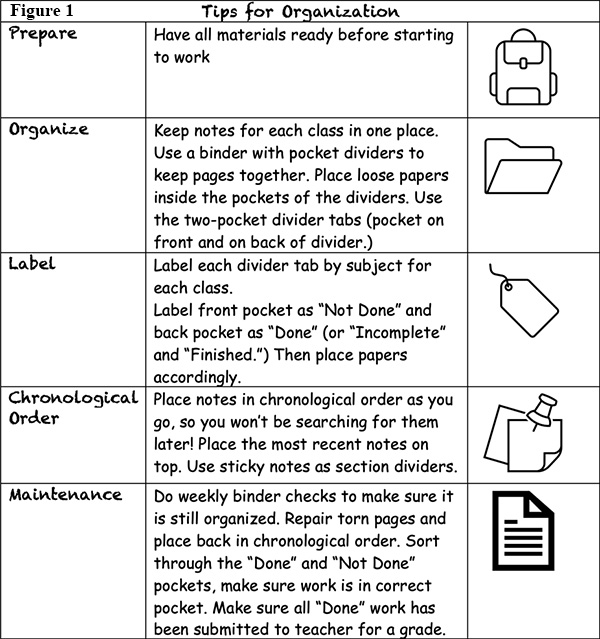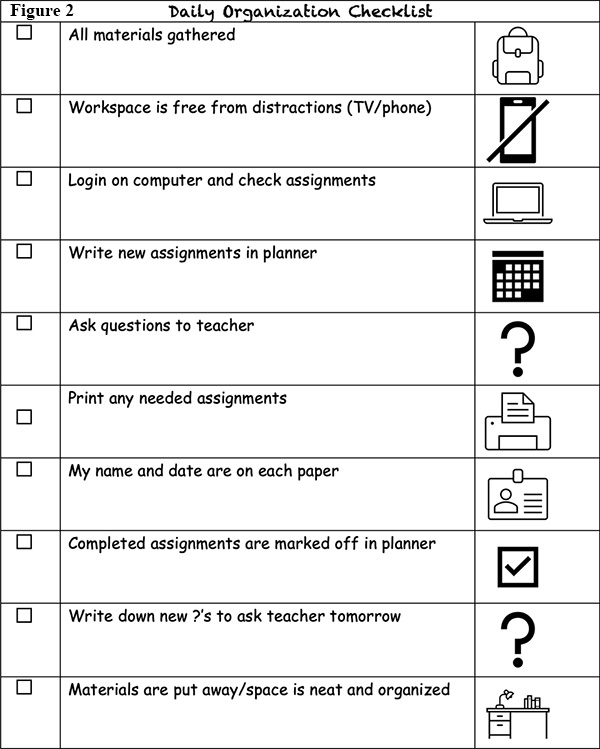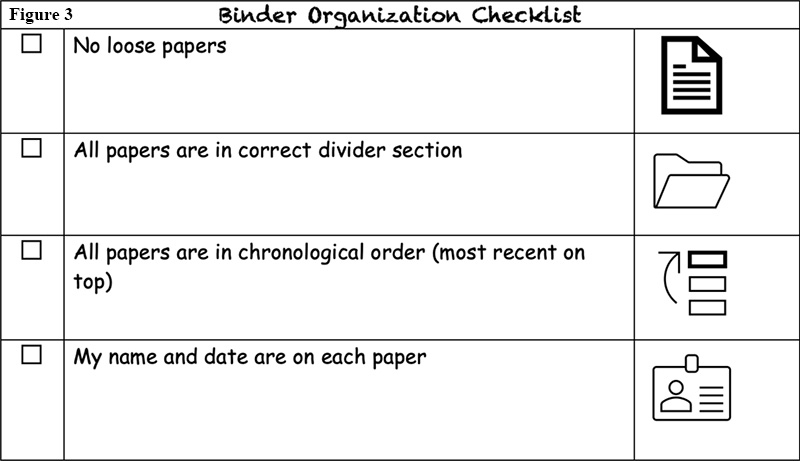Due to COVID-19 pandemic, many K-12 schools have implemented virtual instruction and/or hybrid instruction for all students including students with disabilities. For students with autism spectrum disorder (ASD), lack of organization and inability to stay focused may impact their success in home-based virtual instruction (Barton & Harn, 2012). Without the structure of a well-designed classroom and individualized accommodation in virtual environments, students with ASD may fall behind their peers when working from home via a virtual learning model. Fortunately, visual supports are an evidence-based practice that can easily be embedded into the virtual school day to support learners with ASD in organization and staying on task across the virtual learning day. The purpose of this article is to show teachers, parents, and students with ASD how the evidence-based practice of visual supports can be used to support organization and learning for students with ASD in their virtual learning environment.

Nancy Welsh Young, EdS
Students with ASD often struggle with processing large amounts of new information, unstructured situations, and a lack of predictability (Knight et al., 2014). They may also have difficulty managing their time effectively. These challenges are amplified in a virtual learning environment that can require students to manage multiple sign-ons, organize their own materials and space for learning, determine different teacher’s expectations for creating and turning in work, and meet deadlines. Many students with ASD are able to process visual information quickly and efficiently, so the use of visual support systems may increase independence and reduce the need for verbal prompting from adults (Banda et al., 2009). Visual supports are defined as “Any visual display that supports the learner engaging in a desired behavior or skills independent of prompts” (Wong et al., 2015). Visual supports can include “…pictures, written words, objects within the environment, arrangement of the environment or visual boundaries, schedules, maps, labels, organization systems, and timelines” (Wong et al., 2015). This article explains how to use visual supports to help the student become more organized for virtual learning.
Choosing Visual Supports
The first step is to identify which type of visual support is needed. The parent should consider which area of organization for virtual learning is presenting the most difficulty for their child, whether it is organization of space/materials, time, tasks, or all three. Then they can decide which visual support would be most beneficial. Following are some examples of each.
Visual Support for Organization of Space/Materials – To organize a student’s space, visual boundaries are useful because they help make it clear where learning activities are to take place. For example, in a virtual learning situation, a parent could create natural boundaries in the home to establish a specific area for schoolwork by strategically arranging furniture, placing tape on the floor, or designating a rug as the place to be when working on school assignments.
Implementing visual cues, which are a visual representation in either photographs, symbols, words, or objects, could help the student understand expectations for the work area and materials organization. For example, a parent could place a picture of the space designated for the child’s schoolwork organized and ready for learning. That way, the student could refer to the picture to compare to the current state of the workspace and easily see how it should look.
Visual Support for Organization of Time – Similar to visual cues, visual schedules use photographs, symbols, words, or objects as visual representations, but are created to cover a length of time, such as a segment of class time, part or whole school day, and can be arranged visually to help the student keep track of materials, assignments, and/or time. Parents can create visual schedules for multiple purposes, such as to help their child organize materials for virtual learning. The goal of a visual schedule for organizing materials is to increase independence in managing learning materials and decrease challenging behaviors associated with organizational difficulties.
Visual Supports for Organization of Tasks – A weekly planner by subject is a useful tool, available in many stores, that parents could use to have their child write down upcoming assignments and mark them off as they are completed and turned in. An example of a visual support with general organization tips is shown in Figure 1. The parent should direct the student to review this checklist every week or two to make sure they are maintaining their established organization system for learning materials. The tips include: (a) having all materials ready before starting work, (b) keeping notes for each class in separate pocket dividers (one for each subject), (c) labeling each divider tab by subject for each class and marking one pocket “done” and the other “not done” to store completed and incomplete work, and (d) placing notes in chronological order with most recent on top.

Daily Organization Checklist – An example of a visual support for daily organization, shown in Figure 2, is a checklist. The student can keep the checklist in the front of a 3-ring binder. This allows them to refer to the checklist throughout the day and reduces the need for prompting by an adult. The daily organization list has ten components: (a) gather all materials, (b) clear the workspace from all distractions (tv/phone), (c) log into assignments (if delivered via computer) or get them out to start working (if on paper), (d) write new assignments in planner, (e) mark any long term projects or tests on a monthly calendar, chunking into smaller steps by writing the projected steps to completion on the calendar at reasonable intervals, (f) ask any questions to the teacher about the assignments, (g) print any needed assignments or write them down, (h) put student’s name and date on each paper, (i) mark off completed assignments in the planner, (j) put materials away/clear workspace/organize binder.

Visual Organization of Binder Checklist – The binder organization checklist example is shown in Figure 3. It lists: (a) no loose papers, (b) all papers are placed in correct divider section (by subject), (c) all papers are placed in chronological order (most recent on top), and (d) student’s name and date are on each paper. This checklist should be used as often as necessary, depending on the student’s needs and workload, but not less than weekly to maintain organization within the binder.

Teaching How to Use the Visual Supports
The next step in using the visual supports is to teach the learner the process for its use (Sam & AFIRM Team, 2015). The parent needs to stand behind, rather than beside, the learner when prompting the use of the visual supports. This helps keep the learner focused on the checklist rather than on the person doing the prompting. The parent should use modeling and/or prompting to help the learner get to the assigned area for learning and begin to use the checklist. After completing each assignment, the parent should prompt the learner to check off that activity on the checklist. The parent should repeat these steps until the learner can follow the checklist independently across all activities. The parent should fade the prompting as quickly as possible. The goal is for the learner to rely on the visual supports instead of the parent for prompting.
Conclusion
Students who have ASD struggle with organizational tasks, making virtual learning more difficult. Using visual supports is an evidence-based practice that can help students organize their space/materials, time, and tasks around virtual learning assignments. Visual supports have been proven effective for learners from age three to twenty-two (preschool through high school).
Nancy Welsh Young, EdS, is a PhD Student in the Leaders for Transition Program at the University of Arkansas – Fayetteville. To contact the author, email Nancy at nhochmut@uark.edu.
Additional Resources
JoeSchedule.com – This website provides several free example schedules, and the paid version provides for creating, storing, sharing, and modification of activity schedules online. It also offers an eBook as a How-To Guide for activity schedule ideas.
GoBoardMaker.com – This website is home to the creator Boardmaker®, a leader in communication board symbols.
References
Banda, D. R., Grimmett, E., & Hart, S. L. (2009). Helping students with autism spectrum disorders in general education classrooms manage transition issues. Council for Exceptional Children, 41(4), 16–21.
Barton, E., & Harn, B. (2012). Educating young children with autism spectrum disorders. Corwin.
Knight, V., Sartini, E., & Spriggs, A. D. (2014). Evaluating visual activity schedules as evidence-based practice for individuals with autism spectrum disorders. Journal of Autism and Developmental Disorders, 45(1), 157–178. https://doi.org/10.1007/s10803-014-2201-z
Sam, A., & AFIRM Team. (2015). Visual supports. Chapel Hill, NC: National Professional Development Center on Autism Spectrum Disorder, FPG Child Development Center, University of North Carolina. Retrieved from http://afirm.fpg.unc.edu/visual-supports
Wong, C., Odom, S. L., Hume, K. A., Cox, A. W., Fettig, A., Kucharczyk, S., Brock, M. E., Plavnick, J. B., Fleury, V. P., & Schultz, T. R. (2015). Evidence-Based practices for children, youth, and young adults with autism spectrum disorder: a comprehensive review. Journal of Autism and Developmental Disorders, 45(7), 1951–1966. https://doi.org/10.1007/s10803-014-2351-z




[…] Website […]
[…] Is your child struggling to organize their materials for virtual learning? Education has been forever changed by the covid-19 pandemic. Like it or not, virtual learning is here to stay. In this article, I share some strategies to help them get prepared to engage in online learning from home. https://autismspectrumnews.org/organizing-virtual-learning-materials-for-students-with-autism/ […]
[…] The covid-19 pandemic forever changed education. In this article, I shared ways to help students with autism or other disabilities organize their materials for learning during virtual instruction times. https://autismspectrumnews.org/organizing-virtual-learning-materials-for-students-with-autism/ […]